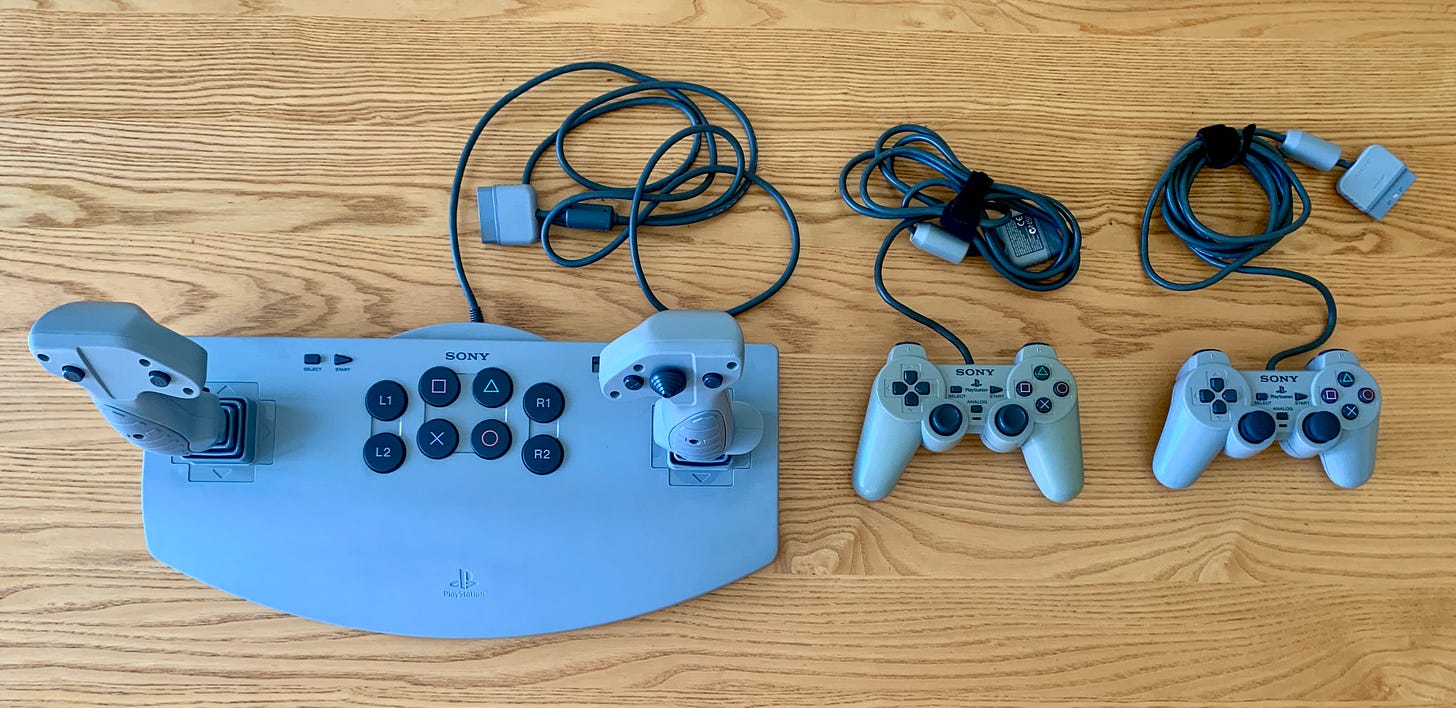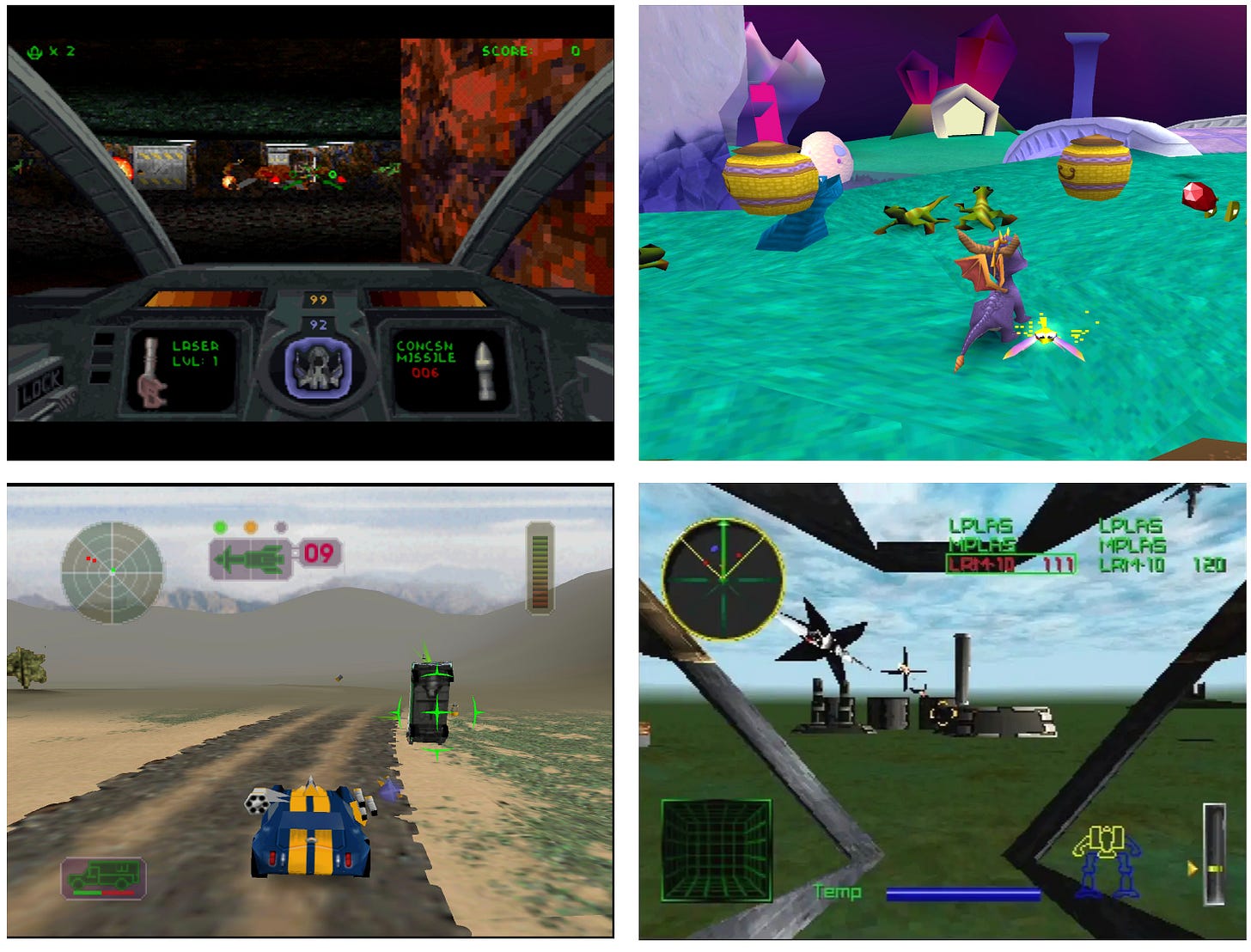Scoring Gear: The PS1 Analog Joystick
Dude! What the f**k is that thing? Pixel Fix pursues Playstation’s peripheral prince and captures the answer.
During the dark days of Covid-19 lockdowns I found myself a visitor to a strange corner of retro gaming - Playstation 1 peripherals. It was a safe place, not particularly popular and almost everything was grey, it suited me nicely. A land of chunky memory cards, multitaps and link cables, but one accessory towered above all others, the Analog Joystick. Many collectors covet the Playstation Mouse, others desire spicy third-party gear like the Wu-Tang Clan controller. For me, when I first locked eyes on the Analog Joystick with its epic proportions and extreme endowment of buttons and switches, I knew it was the one. If you want people to enter your lounge room and say, “Dude! What the f**k is that thing?” Then, the Analog Joystick could be the peripheral for you too.
Now, I get it, you’re scared, you’re used to a piddly little Dual Shock controller in your hands and the Analog Joystick represents awesomeness on a level your unacquainted with. That’s ok, I was once there too, so let Pixel Fix allay your fears and answer your questions.
But seriously, what the f**K is that thing?
It’s Playstation’s Analog Joystick (SCPH-1110), often misnamed, by buffoons, as the Playstation Flightstick. It has twin joysticks and over 20 buttons, switches and triggers. Released initially in Japan in 1996, the Analog Joystick then sold in other global markets. It’s functions are fully supported by around 50 PS1 games and partially supported by all the others. It doesn’t need batteries or require its own power source, it just plugs into the controller port and works. It’s ready to go to war controlling fighter jets, mechs and combat vehicles or it can just look pretty on a shelf. It is Playstation’s Analog Joystick.
Why is it special?
While joysticks weren’t new in 1996, the Analog Joystick had something fresh - potentiometer technology. This tech was superior to the switches and currents in traditional joysticks and meant finer control for players and new possibilities for developers as console gaming embraced 3D graphics. The Analog Joystick will forever be a special piece of gaming technology as It’s the first controller to feature true dual analog control using potentiometers.
As Sony’s first analogue controller for the Playstation, it blazed the trail for the Dual Analog controller that followed and then the Dual Shock shortly after. There’s little family resemblance, but the very same tech in the first Dual Shock originated in the Analogue Joystick. All this went down before staunch rival the N64 was released.
Rumour states the reason Sony’s first Analogue Controller received two thumb sticks was for compatibility with Analog Joystick supported games. The Analog Joystick was bleeding-edge, for the time, and remains an impressive ancestor to all the Dual Shock controllers that followed.
How do you use it?
Each of the joysticks have a selection of buttons, switches or triggers that match the button layout of the original PS1 controller. The right joystick also has a hat-switch which can mimic the directional pad on the original controller. Supported games may use that independently of the two joystick directional inputs, often as a selection tool for weapons or for in-game menus. The standard controller buttons are also repeated in a more familiar arcade stick-style format on the joystick’s base.
There’s a switch on the unit to move between two modes - Digital and Analog. In Analog Mode the controller’s functions are fully available for supported games and that’s cool. The added genius here is that switch the controller into it’s Digital Mode and both joysticks become a simple d-pad replacement. The Analog Joystick then works like a conventional arcade stick with a joystick in your preferred hand and the base buttons to tap on with the other.
What PS1 games are compatible with it?
In Digital Mode, all of them. Familiar games feel like new experiences and even those early Playstation games, that don’t support the Dual Shock controller sticks, will work with it. The 50 plus Analog Mode supported games have an “Analog Joystick Compatible” icon on the back of their case.
Flight games, controlling mechs and tanks all suit the Analog Joystick’s controls, but some first-person-shooters, fighting games and even platformers find a home with it as well. Discovering what games work well is a part of its charm.
Personally, I’ve enjoyed playing Ace Combat 2 and 3 with mine and I’ve heard R/C Stunt Copter is good times as well so I’d like to give that a shot. Other well-known fully compatible games include: Descent, Mech Warrior 2, Sled Storm, Spyro 2, Vigilante 8 and the Syphon Filter games. I can’t vouch for how smoothly all those titles work with the Analog Joystick’s control set. I’d imagine some are epic, while others will have you rapidly returning to the familiarity of the Dual Shock.
A list of fully supported games is available here.
Whats the playing experience like?
To use a 90’s expression, it’s totally rad. On offer is something beyond a unique retro experience, it also functions extremely well and is strongly built. Although, some games are challenging in Analog Mode. Often one joystick is used to move and the other to aim and fire weapons, this requires a different whole-arm type coordination compared to what we’re used to with thumbsticks. Perseverance is rewarded, and a more detailed level of control awaits.
The joysticks offer a good measure of resistance and will snap back to their neutral position quickly. The buttons and triggers on the joysticks feel great and are positioned right where your corresponding fingers naturally rest. While the base buttons can’t match quality arcade options, they’re well sized and spaced.
Does it only work on Playstation 1?
No, playing it on other consoles is possible for keen owners. The Analog Joystick works on the Playstation 2 in digital mode with many games available to play with one joystick and the base buttons. Only a handful of PS2 games are fully compatible in Analog Mode but R-Type Final is one, and could be a good lark.
There isn’t a wealth of info online about cross-console compatibility, however the Wired-Up Retro guy on YouTube is like the Gandalf of this accessory and through his wizard-like use of available adaptors he’s had the joystick connected and functioning on the Wii, PS3/4 and the Xbox 360. A PS1/2 controller to USB adaptor also opens up options to connect to PC or a Retropie. Knowledge around the required adaptors is needed but it’s definitely possible to open up the game libraries of other consoles with full compatibility for the Analog Joystick. Connecting to a Playstation Classic is also possible and provides an elegant solution for HDMI connectivity and game emulation.
It’s worth noting that the Analog Joystick underwent some form of hardware revision, and while appearing identical there are two versions of the unit. One has a “01” ending model number and another with “02”. The numbers are visible on an underside label. Both models function the same under normal use but the “02” variant has superior compatibility, through adaptors, with other consoles.
I also love the Analog Joystick now, how can I get one?
Unsurprisingly, the Analog Joystick didn’t sell strongly when new. It was expensive, large and just too badass for the masses who only wanted to clear the next level of Crash Bandicoot. For the time It was very ambitious in scale and complexity. Also, when the Dual Shock was released the Analog Joystick became redundant in the eyes of all but the hardcore. This is reflected in how many are out there, particularly in NZ where sales were likely minuscule.
The bad news is that you might be waiting a while to find one for sale domestically, the good news is it shouldn’t cost too much when the opportunity arises. For reference, I waited six months from when I fell in love, till i saw one listed on auction website Trade Me. Mine was purchased loose, without it’s original box, for $40 NZD, with only my bid on its auction. Others didn’t share my desire. Shipping was an additional $40 due to it’s bulk. It cleaned up well and luckily the grey plastic hadn’t yellowed, as is the curse of many PS1 consoles and accessories.
If you’re all worked up and gotta have it now, there’s always a few available on eBay, but expect to pay a lot more than 40 bucks, and an painful amount in shipping as well.
What do I do if I score one then my non-gaming partner sees it, gets angry and calls it E-waste?
Firstly, remain calm. Non-gaming partners say hurtful things about large peripherals all the time. You may also be dealing with some jealousy because of the lustful way you’re looking at the Analog Joystick. Standard protocol applies; don’t mention the dollar amount you paid, instead stress what a great deal you got. Gently explain the significance of the Analog Joystick in retro gaming history. Encourage your partner to play with the joysticks and try hard to avoid innuendo comments. Attempt to move on amicably. If that fails, agree to sell one of your Guitar Hero guitars… then don’t.
Thanks Pixel Fix, I was blind but now I see.
No worries partner. If you ever chance across an Analog Joystick out in the wild and you can make it yours, we’d say go hard. It’s possibly the biggest, baddest and sexiest official playstation controller ever made. It’s a cool talking point and the kind of fresh madness many in the retro gaming scene would enjoy. It’ll get you dusting off those old PS1 disks for another thrash, or experimenting with it on different consoles and PC. The Analog Joystick, just pull the trigger.













This was a great read, I never knew this existed. I'll be doing write ups like this for the Dreamcast Mission Stick, racing wheel, twin stick, fishing controller, arcade stick, and so on haha. I love peripherals!
That's cool. It reminds me vaguely of the Xbox's mech controller.